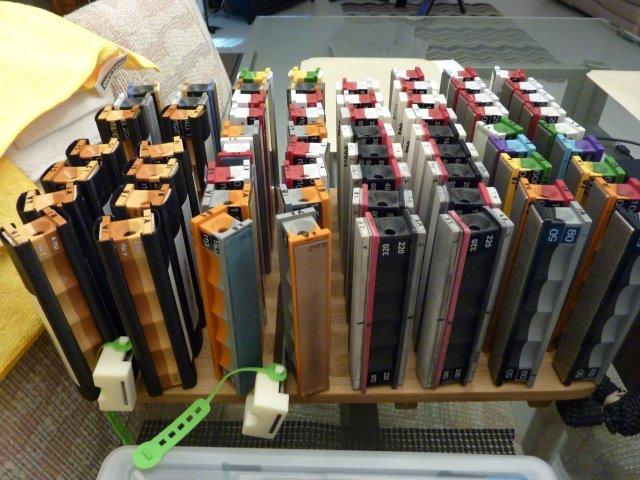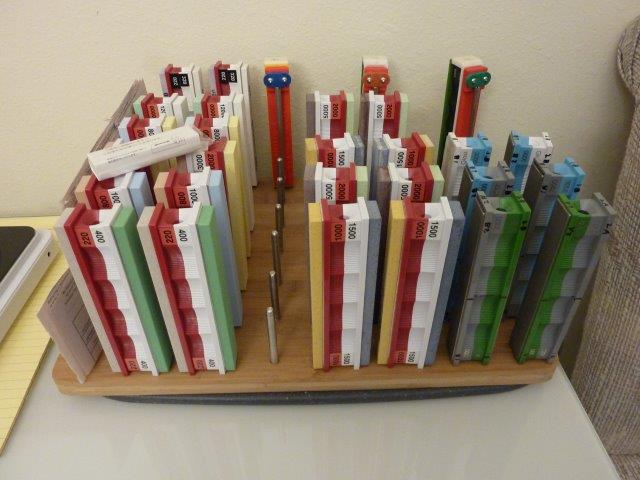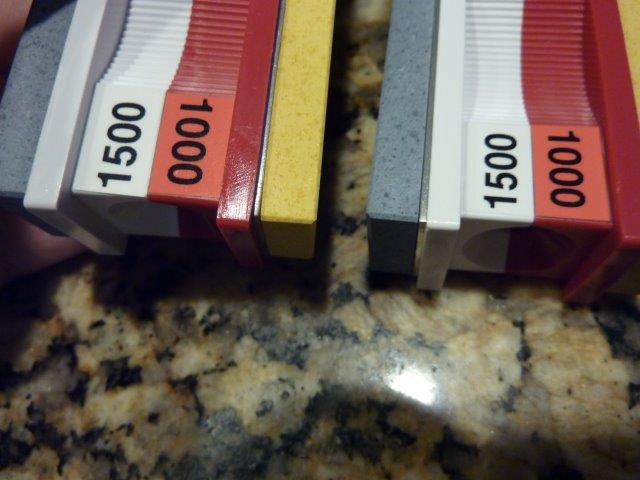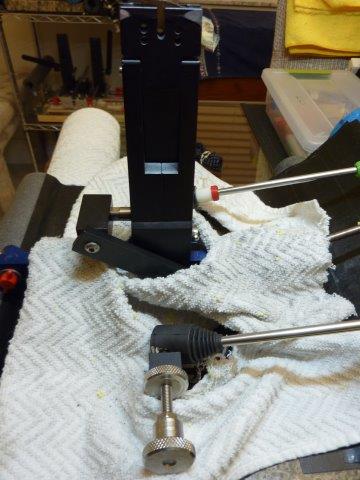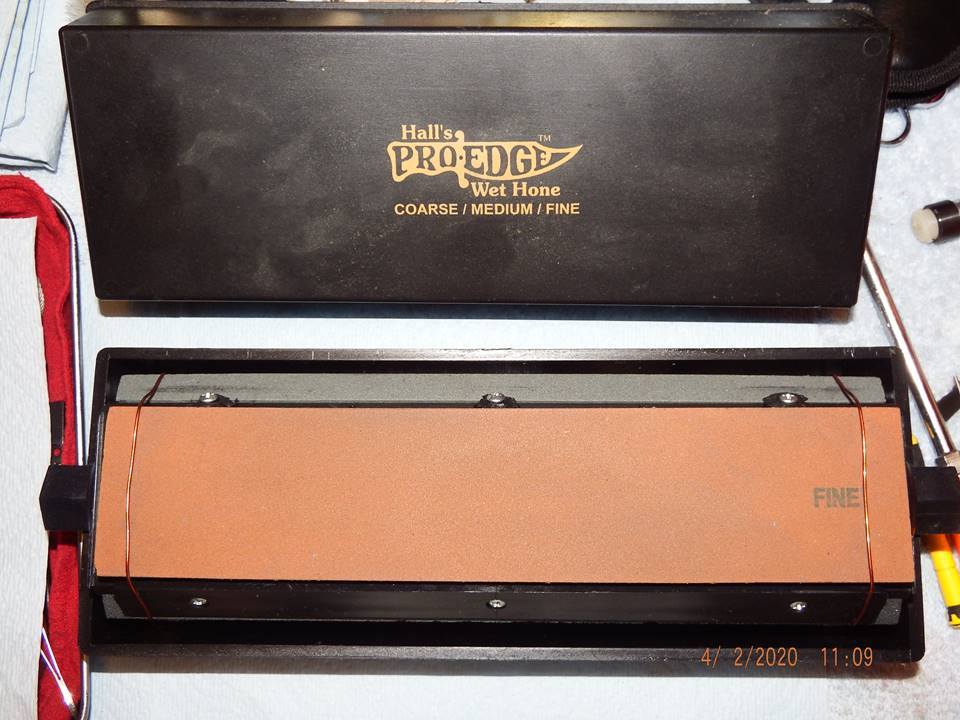Japanese High Carbon
Recent › Forums › Main Forum › Techniques and Sharpening Strategies › Task Specific Knife Sharpening › Cooking › Japanese High Carbon
- This topic has 23 replies, 7 voices, and was last updated 03/25/2021 at 7:23 pm by
 000Robert.
000Robert.
-
AuthorPosts
-
02/24/2021 at 5:14 am #56259
Looking for some help on what grit progression to sharpen these knives (the three longest ones in the photo). Not sure what make they are but the gentleman who brought them to me said he purchased them directly from Japan some years ago.
Before I did anything, I tested the sharpness on some phone book paper and the knives cut through it with little effort – they were sharp. I contacted him and said they were very sharp and he wanted me to just clean up the edge a tad. I put one in my set up – WE130 – and took my 1000 grit stone and lightly went over each edge (they were set up at 15 degrees). I looked through my 250x USB microscope and the clean edge is now very rough – much like a western style knife would be if you reprofiled at 100 grit.
Looking for some advice on how to address this very sensitive/brittle metal
Mike
Attachments:
You must be logged in to access attached files.
02/24/2021 at 10:47 am #56269Mike, I like to think sharpening Japanese chef’s knives is my area of experience. I like to collect them, I regularly use and sharpen these types of knives. The issue with them is there are so many different kinds of steels, both stainless and non stainless, and different steel hardness. These steels can vary greatly in how well or easily they can be sharpened. There is no rhyme or reason or general rules to apply to the different steels, but I’ll try to summarize or give generalities where I can. The discussion of Japanese Chef’s knives can be long and involved because there are so many different knives of different styles for different uses, made from a large variety of different steel. (I tend to get too deep into the discussion, also.)
High Carbon steel is generally used as a term to categorize the non-stainless steels, but there are also some High Carbon stainless steels. I’m not trying to correct your use of the terminology, just to share that with you. I’ll use SS for stainless steels and NSS for the non-stainless steels, here in this forum thread.
I used to think the High Carbon NSS were easy to sharpen and sharpened quite well to yield extremely sharp results. As I acquired more chef’s knives made of more different steels I learned that rule didn’t necessarily hold. The only way I learned the characteristics of the different steels was by sharpening each knife.
I learned early on that many of these Japanese Steels, both the SS and NSS will not sharpen, or sharpen well with W.E. diamond stones. That is when I had to begin using Japanese whetstones mounted on W.E. paddles. I have not come across any Japanese Steels I cannot sharpen with the whetstones. They still may not be easy to sharpen, even with the whetstones, but they can be sharpened. Most of them well. My experience was roughly like your, even when trying a relatively fine grit diamond stones, like the W.E. 1000 grit, it left a rough ragged edge, I wouldn’t expect from such a fine grit.
The first place I like to start is to know the steel type and Rockwell hardness. Sounds like that’s a dead end for you. It does help some knowing which steel it is, but it won’t tell you everything. In general SS harder then a steel like VG10 @ HRc 60-61, for example, requires the use of whetstones. But, depending on how the steel is made I’ve found some VG10 steels may be hardened in a way that one makers VG10 is harder, more brittle and chip prone, then another maker using the same VG10 steel. The sharpening characteristics between the same SS used by the two different makers may be day to night. The only way to really determine how well the steel can be sharpened is to try to sharpen it.
I will say it’s easier and quicker to sharpen knives with the W.E. diamond stones then to use the whetstones. The diamond stones are more consistent in thickness and they’re magnetic so it’s easier and quicker to working with your angle cube to make angle and micro-angle adjustments. Whereas the whetstones are non magnetic, a little messy and consumable. They wear done and require lapping/maintenance to keep them flat and true. I use a magnetic stone adapter to facilitate using the angle cube on the whetstones.
Enough of the backround….I knew I would get too involved…
The first two on the left appear to be the typical chef’s style knives called Gyutos. They look to be around 8″ or 210mm, I’m guessing.
The first one is made with a black coating that’s intended to inhibits the steel from reacting and also can help with food release from the blade. It does have some blackened or mottled appearing steel, called patina, on the blade path or Kiriba, from when the knife steel reacted with acidic foods.
The second Gyuto with it’s more uniform dull gray color and appearance may be a SS knife, or it may have a SS cladding. That is it’s NSS in the core and the blade’s cutting edge, with layers of softer SS on the outside. The SS cladding is to help with edge durability and to make it easier to maintain.
The fifth knife from the left, the long thin knife is obviously NSS and has reacted to foods causing the mottled black patina. I’m guessing this is a Yanigiba or Sushi knife, (although that knife type are often single beveled knives) or it may be a Sujihiki or Japanese slicing knife. Some Japanese knives are made to emulate the blade shape and characteristics of more traditional Western or European type knives, so it’s hard to tell, for sure. (I can’t see the tip on that long knife but it appears it may be angled or broken off).
The knives can be sharpened well with the W.E. sharpeners, but not with the diamond stones. From your initial post it sounds like you will need to be using whetstones to sharpen them. I enjoy using these Shapton Pro Stones. These are a “splash and go” type of whetstones. You just spritz them with water to use them. I’ve been using these stones and some other type whetstones for many years now with very good results. There are other whetstone types requiring a full soaking in water. How the two types of whetstones are used is slightly different.
It is a pretty expensive initial investment you’ll need to make, to get into whetstones. It’s another different skill set you’ll need to learn, too. The sharpening strokes are the same as the ones we use sharpening with the diamond stones. I linked the seller where I made my most recent purchases, above. There are only a few makers of these whetstone set-ups, out there, that I have come across. Most of these makers are in home or small shops made by guys cutting full size Japanese Whetstones with tile wet saws. Pretty much any brand of whetstones that can be purchased and cut, can be used. As long as you have someone willing to make them or if you can make them yourself. Then they’re mounted to a backing plate then mounted onto original W.E. paddles. Prices vary depending on the grits, finer grits are pricier. A full set can be $1000 to $1500, or more, depending on how complete the stone sets are. Also maintenance lapping plates will be needed. Another initial expense.
I can’t see getting into this discussion any deeper here because IMO the whetstones are the only way to move into sharpening these steels that you can’t sharpen with the W.E. diamond stones. I’m happy to help you further if I can. The discussion can be endless…each Japanese steel I’ve sharpened has it’s own nuisance, but the whetstone sharpening method I’ve learned generally works well for all the steels. Just some are harder and trickier to sharpen then the others.
Marc
(MarcH's Rack-Its)Attachments:
You must be logged in to access attached files.
02/24/2021 at 5:21 pm #56279Thanks Marc – some great information and feedback in your thread. The steel on the 2 on the left and the far right (according to the owner is VG10) and the one second from right is a slicing knife. He mentioned to me that he has a similar knife for sushi.
I did use my traditional whetstones on them to clean them up as I used whetstones for about 8 years prior to purchasing the WE130. Before I make that jump to the whetstone paddles for WE, I will wait to see if I come across any more. I have done many SS Japanese knives my first encounter with NSS and VG10
Appreciate the timely feedback and advice
Mike
1 user thanked author for this post.
02/25/2021 at 12:11 pm #56288I used to think that high carbon nss was simple to sharpen with the WE diamond stones but I learned that’s not necessarily always the case. Some of the low hardness high carbon nss like HRc 56-58 sharpened like butter. I even found some hc nss harder steels like Aogami Super @HRc 63-64, which is much harder even than VG10 ss, @HRc 60-61, yet it still sharpened easily and beautifully well. But then when I tried other hc nss, some that I tried to sharpen were even harder, others were somewhat softer, but as soon as I touched the edge of these steels with even the very finest grit diamond stones the apex went ragged. But these same steels sharpened well with whetstones. I haven’t been able to come up with general sharpening rules or to make any sense of it.
I can say I have found the harder ss, like the micro fine and powdered steels, can’t hardly be touched with diamond stones because either they’re just too hard, or too brittle. For many hard ss the edge simply failed and fell away with diamond stones. All these difficult steels I found could be sharpened with whetstones with varying degrees of ease or difficulty and the right amount of care.
Here’s a link discussing Japanese knife steels that should be worth reading.
Marc
(MarcH's Rack-Its)3 users thanked author for this post.
02/25/2021 at 4:33 pm #5628902/26/2021 at 4:38 am #56292Thanks Marc – very good read – appreciate it
Mike
03/04/2021 at 10:16 am #56342Agreed, Marc, this is very interesting reading. I’ve never gotten into the whetstone process. All my sharpeners are diamond, ceramic or oilstones.
How do you deal with changes in stone thickness changes after lapping? Do you check angles with each grit change, or do you use the Variable Stone Thickness Adapter (which doesn’t work on the Gen 3 Pro)?
Also, I always wondered about effective whetstones would really be on the WE, as opposed to the traditional, horizontal use. It was my understanding that whetstones used a slurry of loosened grit to work the steel and that in a vertical application like the WE, the slurry would tend to fall away from the point of contact. What is your take on it? Obviously, it works, so my theory must be flawed.
1 user thanked author for this post.
03/04/2021 at 11:29 am #56347How do you deal with changes in stone thickness changes after lapping? Do you check angles with each grit change, or do you use the Variable Stone Thickness Adapter (which doesn’t work on the Gen 3 Pro)? Also, I always wondered about effective whetstones would really be on the WE, as opposed to the traditional, horizontal use. It was my understanding that whetstones used a slurry of loosened grit to work the steel and that in a vertical application like the WE, the slurry would tend to fall away from the point of contact. What is your take on it? Obviously, it works, so my theory must be flawed.
Tom:
I always check my set angles with each and every grit change and make micro-angle adjustments as necessary, no matter which medium I’m working with. I do not use the VSTA. It doesn’t afford the precision of the DXL360S cube. Yes, lapping the whetstones to maintain them for level and flatness does affect the stone’s thickness so it’s hard to find used stones, that have been lapped, that have the same thickness.The whetstones can be used with any sharpening strokes you choose. Just like you would use with the diamond stones.
With whetstones you do need to know what kind you’re working with. Some whetstones, in particular the stones requiring soaking, like the Naniwa Chosera stones do need the muddy slurry developed so they can cut the steel. (This slurry can be developed by rubbing the two water soaked whetstones, of the same, grit together).
Other whetstones, like the “splash and go” type work simply with a spritz of waterto the stone’s surface. They do not need the slurry to cut effectively. These “splash and go” type whetstones are not really messy to work with. The Shapton Kuromaku Pro stones are one of the “splash and go” stones I use regularly.
I have been working with a small towel laying over the W.E. base for years. I cut or rip the towels to allow me to fit the towel around the vise and the end brackets. I use the towels all the time, wet or dry, to catch steel dust with the diamond stones and any moisture from spritzing or stone debris that may drip or fall from the knives or whetstones during sharpening. When the towels get dirty, I switch them out for a new towel, which is not really very often.
I always use a small patch of real leather chamois cloth in the jaws to help give me a good clamping hold on the knives. The chamois patch also absorbs any wet steel and stone run off that drips off the knife and the whetstones during sharpening and keeps it out of the vise’s inner workings.
Marc
(MarcH's Rack-Its)Attachments:
You must be logged in to access attached files.
03/22/2021 at 7:56 am #56433I am new to Japanese knives. After acquiring a set of 5 for a tad less than $1700 I was a little upset that my $1500+ WE system would destroy these blades. I have everything from Blue #2 to HAP40 steels which is 65 on the Rockwell scale. Thank goodness I did my research first. I went out and bought a Shapton Glass set 500-1000-4000-8000 and a stropping set of 1-.5 micron for a few hundred. I never have used stones before but with my WE experience I understood the concepts and after a couple hours of youtube videos I picked it right up. I am glad I made this decision vs going down the rabbit hole of whetstones for my WE. As long as you aren’t reprofiling all one needs is a 1000 and 4000 stone and a good strop setup. If I ever need a chip taken out or feel I need one reprofiled I will send it out for $20.
03/22/2021 at 9:41 am #56434I am new to Japanese knives. After acquiring a set of 5 for a tad less than $1700 I was a little upset that my $1500+ WE system would destroy these blades.
MIKE, I started to respond to your post three times and deleted my typing, each time. I don’t wish to get into a heated argument with you or make an enemy but I’m uncomfortable with your reasoning, your characterization and portrayal of the Wicked Edge Systems.
The W.E. System does not do anything to any blades. The W.E. is nothing more then a well designed and well machined bench vise with precision adjustable angle jigs. The owner/operator of this precision hand tool bears all responsibility for the results of it’s use. To blame any results on the W.E. system is just wrong. It does take some time and practice to use the W.E. well. It’s not hard to use a W.E. but it’s not always so simple, either. The are many different knives of different sizes and shapes. It takes a bit of experience to make the best use of the W.E. with all the variety of knives and steels you’ll want to sharpen. Sometimes it requires that we think outside the box.
Your observation is correct, but the stated conjecture is misplaced. It’s not the W.E. that would destroy your new prized knife collection but the sharpening mediums you choose to employ with your WE130 to maintain them. This you undoubtedly recognized by your choice to purchase a set of Shapton Glass Whetstones to maintain your knives. I too use Shapton Glass Whetstones, along with other types of whetstones. They are mounted on W.E. paddles allowing me to continue using the W.E. to sharpening everything.
Going “down the rabbit hole” for me, is a good thing, a fun thing. I find becoming fully immersed in my hobbies and wanting more knowledge, involvement and experiences rewarding on so many levels. I’m fortunate, equating my experiences to the monetary aspect seldom needs to come into consideration or the discussion. Once in a while I have to “back burner” a purchase for a while. I pick up where I left off when the time is right, again. It’s my hobby, my knife collecting and sharpening them, that I enjoy everyday, every time I use one of these knives.
I bought the W.E. to use it. Why draw the line? I want to use my best knife sharpeners on my best knives with the best sharpening mediums needed to produce the best results I can. To stop short, to draw the line, for me wasn’t an option. I continued down the rabbit hole with these sharpening mediums like you found you need to use. I prefer to use those mediums made to be used with my W.E. sharpeners. That’s become a new fork in the “rabbit hole” tunnel as I delve even deeper into the whetstone world trying to find the kind or brand of whetstones that can give me the results I seek all while still using my Wicked Edge set-ups.
Marc
(MarcH's Rack-Its)03/22/2021 at 1:46 pm #56440I guess I’m missing something here: How are WE diamond stones going to “ruin” a steel blade?? My guess is that “steel” in the steel blade isn’t what it’s claimed to be. Has anyone had the “ruined” blades Rockwell tested before they started pointing fingers at the WE system?
03/22/2021 at 4:16 pm #56448Here’s a photo of my stones, Marc. I’m not sure why you don’t want to talk here but that’s ok. I would still Rockwell test the Japanese steel before I blamed diamond stones.
Attachments:
You must be logged in to access attached files.
03/22/2021 at 5:16 pm #56451Marc. I’m not sure why you don’t want to talk here but that’s ok.
000Robert, this very wierd. Am I missing something? I feel like you think your confronting me or challenging me to something. Like I’m hiding something. I have nothing to hide or to prove to you or anyone else. I share my personal sharpening experiences when using the W.E. That is all.
I have had these experiences not being able to sharpen steels, and on occasions damaging the edge steel using the W.E. diamond stones. This occurred on many different occasions. With many different steels. I was able to sharpen these same steels well using my whetstones. On other occasions I found I simply preferred the sharpening results when using the whetstones as compared to the sharpening results I produced on these same steels with the diamond stones. I found the remedy to my situation was to choose an appropriate sharpening medium that gives me the results I prefer. My conclusion based on my years of sharpening experiences using my Wicked Edge Systems is sometimes a different sharpening medium then the diamond stones is preferable. This is my opinion formed based on my sharpening experiences.
When I can use W.E. diamond stones I always go with them because it’s a simpler and easier process to use. The magnetic sharpening stones facilitate the use of the digital angle cube. (Which I use with each and every grit change.) When I don’t see the results or outcomes I want to see, or I prefer to see, I go with a different sharpening medium that will produce these results I expect.
These experiences have been on too many occasions with too many different steel types. There was no rhyme or reason to correlate my experiences with steel hardness. I’ve experienced this issue where the diamond stones didn’t work to my liking with both stainless steels and non-stainless steels of all various hardnesses, from moderate to super hard steels
I never would think the steel was problematic and should be tested for hardness. I just wanted to sharpen my knife’s edge while enjoying my hobby. The whetstones allow me to do this when I use them. To get the results I want, when I can’t get those desired results using the diamond stones.
Marc
(MarcH's Rack-Its)1 user thanked author for this post.
03/22/2021 at 5:44 pm #56453Sorry Marc, I meant no disrespect or anything. You have helped me and many others here a great deal and I appreciate it. I just meant that it helps everyone when all can see. That’s all I meant. I guess I should think about how I word things and the possible ways people can interpret it before I submit comments. I’m not very good at online talking. I guess it’s a good thing that I don’t have a FB or Twitter account! LOL!
I just have a hard time believing that diamond stones cannot sharpen any hard steel well, assuming that the steel is really hardened and heat-treated properly. Buck Knives is famous for their heat-treating. And my Buck 301 pocketknife has steel so hard that the whetstones in my Hall’s Pro Edge will not even scratch it. I have to use diamonds to sharpen it. The steel in that pocketknife is what led me to Blade Forums and then to Wicked Edge and got me on the search for more knowledge about steel and sharpening. It’s now one of my main hobbies.
1 user thanked author for this post.
03/22/2021 at 6:06 pm #56454Apology heard and accepted.
We’re getting off the topic subject here, “Japanese H C” but…
I’m confused by your characterization of your Buck knife’s steel as ” so hard”. My understanding is its 440HC SS at HRc 56-58. Which in today’s popular knife steels is just a moderately hard steel. I don’t consider a steel as “hard” until at least HRc 60. But that’s my personal delineation.
Why you had difficulty sharpening it with the Pro Edge Tri Stone, I have no idea. I can only suggest, all whetstones are not the same. Some are better for harder steels others not so good.
FYI: There are many blogs describing carbide breakout and other steel damage experienced using diamond sharpening stones. What I experienced and share is not a very rare situation. https://scienceofsharp.com/ and http://knifesteelnerds.com/ are a couple of these.
Marc
(MarcH's Rack-Its) -
AuthorPosts
- You must be logged in to reply to this topic.
